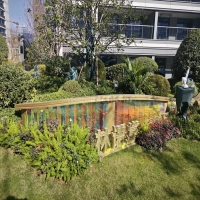Welcome to the website for landscape facilities products and knowledge.
How can a landscape bar counter be designed to maximize space efficiency in small outdoor areas?
Designing a landscape bar counter for small outdoor areas requires strategic planning to maximize functionality without overwhelming limited space. The key lies in selecting space-optimized designs that serve multiple purposes while maintaining aesthetic appeal.
Vertical integration presents one of the most effective approaches. Instead of traditional horizontal counters, consider wall-mounted foldable bars that disappear when not in use. These installations can feature downward-folding mechanisms with secure locking systems, providing substantial surface area during entertainment hours while reclaiming space afterward. Complement this with vertical gardening systems incorporated into the bar's structure, where herbs or decorative plants grow upward rather than consuming precious floor space.
Material selection significantly impacts spatial perception. Light-colored, smooth materials like composite decking or polished concrete create visual expansiveness. Transparent elements, such as glass bar tops or acrylic shelving, maintain sight lines through the space, preventing the bar from creating visual barriers. For standing-room-only areas, narrow-profile designs measuring 12-16 inches deep provide adequate serving space without protruding excessively into the limited area.
Multifunctionality transforms single-purpose bars into space-efficient assets. Incorporate built-in storage that doubles as seating with flip-top lids, hiding bar tools while providing impromptu stools. Ice buckets can be recessed into the counter surface, and drainage systems can be integrated to handle both beverage preparation and plant watering needs. For truly compact solutions, rolling cart bars with locking wheels offer flexibility, serving as a stationary feature during gatherings and storing compactly against walls when unused.
Lighting plays a crucial role in spatial perception. Under-counter LED strips illuminate the area without bulky overhead fixtures, while strategically placed mirrors behind the bar create depth illusions. For corners often wasted, triangular-shaped bars maximize every inch while creating natural conversation areas.
The integration level with existing architecture determines space efficiency. Built-in counters along perimeter walls or fences utilize otherwise dead space, while peninsula-style designs attached to existing structures avoid consuming center space. For freestanding options, slim profiles with vertical emphasis prevent the bar from dominating small patios or balconies.
Ultimately, successful small-space bar design balances proportion, functionality, and visual lightness. By prioritizing vertical development, multifunctional features, and thoughtful material choices, even the most compact outdoor areas can accommodate sophisticated beverage stations that enhance rather than compromise the available space.
Related search:

Recommendation
Metal and acrylic color-changing combined curtain wall for large-scale public landscape facilities